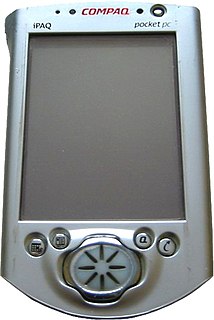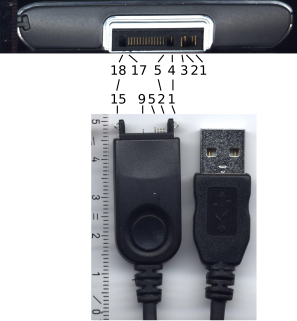
A personal digital assistant (PDA), also known as a handheld PC, is a variety mobile device which functions as a personal information manager. PDAs have been mostly displaced by the widespread adoption of highly capable smartphones, in particular those based on iOS and Android.

Palm OS is a discontinued mobile operating system initially developed by Palm, Inc., for personal digital assistants (PDAs) in 1996. Palm OS was designed for ease of use with a touchscreen-based graphical user interface. It is provided with a suite of basic applications for personal information management. Later versions of the OS have been extended to support smartphones. Several other licensees have manufactured devices powered by Palm OS.

A Pocket PC is a class of personal digital assistant (PDA) that runs the Windows Mobile or Windows Embedded Compact operating system that has some of the abilities of modern desktop PCs. The name was introduced by Microsoft in 2000 as a rebranding of the Palm-size PC category. Some of these devices also had integrated phone and data capabilities, which were called Pocket PC Phone Edition or simply "Smartphone".

Palm was a line of personal digital assistants (PDAs) and mobile phones developed by California-based Palm, Inc., originally called Palm Computing, Inc. Palm devices are often remembered as "the first wildly popular handheld computers," responsible for ushering in the smartphone era.
The Zire Series was Palm, Inc's "consumer-grade" brand of Personal Digital Assistant.
Arch Linux is a Linux distribution created for computers with x86-64 processors. Arch Linux adheres to the KISS principle. The project attempts to have minimal distribution-specific changes, and therefore minimal breakage with updates, and be pragmatic over ideological design choices and focus on customizability rather than user-friendliness.

The Tungsten series was Palm, Inc.'s line of business-class Palm OS-based PDAs.

Windows Mobile is a discontinued family of mobile operating systems developed by Microsoft for smartphones and personal digital assistants.
Non-Volatile File System (NVFS) is a flash memory file system introduced in the release of Palm's Personal Digital Assistant handheld models Tungsten T5, Tungsten E2, Palm TX, Z22, Treo 650/700/680/755p, and Palm Centro.

The LifeDrive is a Palm OS-based handheld personal digital assistant device that was produced by PalmOne, a former incarnation of Palm, Inc. The device was PalmOne's first and only foray into the "Mobile Manager" device category. As its name suggests, Palm intended the LifeDrive to be capable of providing all the capabilities and data storage space that a user could possibly need during the course of the day, including contacts, calendar, music, images, video, and applications. At the time of release, the 4-gigabyte capacity that was chosen for this task could not be achieved using the flash memory used by most PDAs, while keeping the cost of the device low enough for consumer purchase. For this reason, a 4 GB microdrive hard disk drive was selected for the task. It featured a separate data partition that could be used as a portable disk drive. The LifeDrive featured Bluetooth and Wi-Fi connectivity, the first Palm handheld to feature both. The device came pre-loaded with eReader, Documents To Go, and WiFile software.

The Palm Multi-Connector is a power, audio and data interface connector designed by Palm, Inc.
Push email is an email system that provides an always-on capability, in which new email is actively transferred (pushed) as it arrives by the mail delivery agent (MDA) to the mail user agent (MUA), also called the email client. Email clients include smartphones and, less strictly, IMAP personal computer mail applications.

Blazer was a web browser available for Palm handhelds running Palm OS 3.1 or higher.
Several Palm (PDA) enthusiasts have successfully documented internal and external handheld battery modifications to allow longer charge times for their handheld device. Rapidly advancing battery technology allows smaller and longer-lasting batteries to be placed into the space of the original batteries. Modifications of this type can be technically challenging and will almost certainly void any manufacturer warranty and have the potential to damage the modified device permanently.

The Jornada was a line of personal digital assistants or PDAs manufactured by Hewlett-Packard. The Jornada was a broad product line that included Palm-Size PCs, Handheld PCs, and Pocket PCs. The first model was the 820, released in 1998, and the last was the 928 model in 2002 when Compaq and HP merged. The Jornada line was then succeeded by the more popular iPAQ model PDAs. All Jornada models ran Microsoft Operating Systems that were based on Windows CE.

The Pandora is a operating system, handheld game console and mobile personal computer originally released in 2010. It is designed to take advantage of existing free and open-source software and to be a target for homebrew development. It includes several features that no handheld game consoles have previously had, making it a cross between a handheld game console and a subnotebook. It is developed and produced by OpenPandora, which is made up of former distributors and community members of the GP32 and GP2X handhelds. Until 2013, multiple batches of slightly updated Pandora variants were produced. In 2014 the development of a redesigned and upgraded successor, called DragonBox Pyra, was started.

webOS, also known as LG webOS and previously known as Open webOS,HP webOS and Palm webOS, is a Linux kernel-based multitasking operating system for smart devices such as smart TVs that has also been used as a mobile operating system. Initially developed by Palm, Inc., HP made the platform open source, at which point it became Open webOS.
Novarra was a mobile internet software company founded in 2000 and based in Itasca, Illinois, USA. It created web-based services such as web internet access, portals, videos, widgets and advertising for mobile devices. Novarra provided access to the internet and other services through wireless handsets, PDAs and laptops and sold directly to operators, mobile handset manufacturers and internet brand companies. In 2010, Nokia acquired 100% of Novarra's shares.

The GCW Zero is a Linux-based open-source handheld video game console created by a start up, Game Consoles Worldwide. The GCW Zero was funded by a successful crowdfunding campaign on kickstarter.com on 29 January 2013 with US$238,499 collected, originally aiming for $130,000. The project was created by Justin Barwick. The device was eventually released that year.












